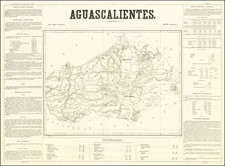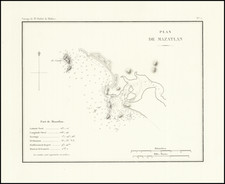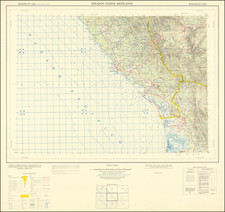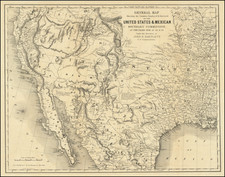Pre-Conquest Histories: Chapultepec - Coyotepec
An early 19th-century watercolor that depicts historical events in the Valley of Mexico during the 15th-century before the arrival Hernan Cortes.
The central motif in the top section of the watercolor clearly depicts the glyph for Chapultepec, consisting of a grasshopper (chapulin) on a large hill (tepetl). Also shown are two human figures swimming in flowing waters integral to the glyph. Four framed Aztec date symbols record the timeframe for the events shown. The lower half of the watercolor relates a different perhaps related history, with two of its own date symbols. Here we see a glyph for Coyotepec appearing in the lower left corner, among several other figure-based glyphs, some of which represent deities.
The present watercolor is a faithful copy by Capt. William H. Shippard of plates 129 and 130 in vol. 2 of Lord Kingsborough's Antiquities of Mexico (1831), a color lithograph by Agostino Aglio. Edward King (Lord Kingsborough) was an Irish aristocrat and antiquarian who sought to gather evidence to support his belief that the indigenous peoples of America were descendants of one of the Lost Tribes of Israel. He is remembered today for publishing the monumental, illustrated work Antiquities of Mexico, which sought to present complete facsimiles of numerous important Aztec codices held in various European libraries. The project bankrupted Kingsborough and contributed to his early death through his contracting of typhus while in debtor's prison.
Codex Vaticanus A (3738), also known as the Codex Rios, is a Mexican codex that was created between 1570 and 1589. Held in the Vatican Library, its 101 pages comprise various sections, covering cosmological, mythological, and ethnographical topics. It is also known as Codex Rios and is understood to be an augmentation of a Spanish colonial-era manuscript, Codex Telleriano-Remensis, that is partially attributed to Pedro de los Ríos, a Dominican friar who worked in central Mexico between 1547 and 1562. The codex itself was likely written and drawn in Italy after 1566.
The Codex Rios as a whole is focused on the Tolteca-Chichimeca culture of the Tehuacan Valley in modern-day Puebla and Oaxaca.
It can be divided into seven sections:
- Cosmological and mythological traditions with emphasis on the four epochs.
- An almanac, or tonalamatl, for the 260-day divinatory year common in Mesoamerica.
- Calendar tables for the years 1558 through 1619, without drawings.
- An 18-month festival calendar, with drawings of the gods of each period.
- Ritual customs, with portraits of Indians.
- Pictorial chronicles for the years 1195-1549 beginning with the migration from Chicomaztoc and covering later events in the Valley of Mexico.
- Glyphs for the years 1556 through 1562, without text or additional drawings.
The present watercolor is most likely based on a page from the 6th section of pictorial chronicles.
William Henry Shippard's Mexican Paintings
William H. Shippard (1803-1865) was a pioneering 19th-century British museologist - an unsung progenitor of modern-day museum anthropology. While he is chiefly remembered as a friend of George Catlin, Shippard's profound interest in the ancient civilizations of Mexico connects him with a cohort of British contemporaries that include Lord Kingsborough and the showman William Bullock. Shippard's fascination with Mesoamerica propelled him to amass a significant collection of visual material derived from Aztec codices which he copied himself. A figure of some intrigue and scholarly ambition, Shippard endeavored to establish the Museum of Mankind in London, which seems to have evolved from his deep interest in early Mexican cultures. Although the museum did not come to fruition, Shippard's original artwork, mainly pen and ink drawings enriched with vibrant hand coloring, based on Mexican codices held in European libraries and collections, remains a valuable historical source, particularly for understanding the allure of Mexican antiquity within early 19th-century British collecting circles.
Capt. William H. Shippard, a friend of George Catlin and an avid watercolorist and museologist, was also a pioneering British Mesoamericanist. Shippard appears in British newspaper notices from the 1840s as a London-based lecturer who spoke about Native Americans and Mexican antiquities. We know he was a friend of George Catlin, and that he was involved in attempts to organize early London museum exhibitions of Mexican antiquities. In the latter efforts Shippard would seem to coincide with a group of like minded prominent English collectors interested in Mexican topics active during the 1820s and 1830s, including Lord Kingsborough and the bibliomaniac Sir Thomas Phillipps, among others. He seems to have been an armchair anthropologist and would-be museum founder, whose ambitious ideas for a London-based museum never got off the ground - at least not beyond the prospectus-printing stage. Certain aspects of Shippard's career are akin to William Bullock, the showman and connoisseur of Mexican antiquities who actually did travel to Mexico. Bullock published a notable book about his Mexican travels, and achieved a level of recognition in his day as the empresario of London's Egyptian Hall, wherein he thrilled large London audiences with his elaborate exhibitions of exotica, including Mexican items.











![[ Baja California / Gulf of California ] Carta Esferica de las Costas y Golfo De Californias Llamado Mar De Cortes Que Comprende desde el Cabo Corrientes hasta el Puerto de San Diego Construida …. 1825](https://storage.googleapis.com/raremaps/img/small/102732.jpg)
![Ferrocarril de Mexico á Toluca y Cuatitlan Plano Topografico del terreno explorado entre Mexico y Toluca, con las diversas lineas estudiadas para el trazo de la via. Levantado y Dibujado por disposicion del Sr. Mariano Rivapalacio. [Railroad from Mexico [City] to Toluca and Cuatitlan. Topographic map of the terrain explored between Mexico and Toluca, with the various lines studied for the route layout. Surveyed and drawn by order of Mr. Mariano Rivapalacio.]](https://storage.googleapis.com/raremaps/img/small/88860.jpg)

